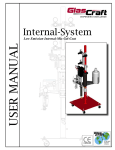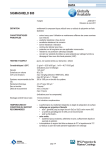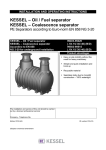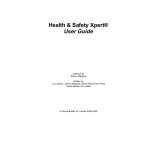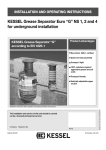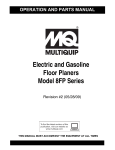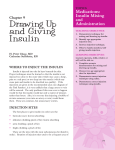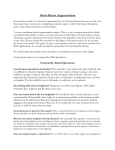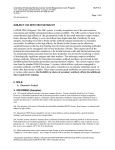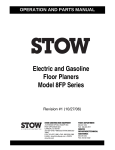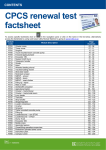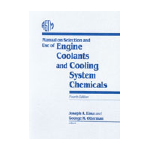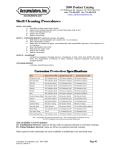Download 1726 2013-05 sigmashield 4800 4801 application an user manual
Transcript
INFORMATION Sigmashield 4800 / 4801 Application & User Manual a fifteen page issue 1726 May 2013 GENERAL The purpose of this manual is to provide information relating to the safe handling, storage and use of Sigmashield 4800 / 4801 products from PPG Industries. The notes within this manual are given in good faith and are to be considered supplementary to other information such as the Technical Data Sheet and Material Safety Data Sheet (MSDS) available from our web site. It is stressed that the user of Sigmashield 4800 / 4801 must ensure that they carry out a full risk assessment in line with their Duty of Care and other Legislative Requirements as appropriate. The user is also advised to read various guidance documents issued by the UK HSE for the safe handling and storage of Organic Peroxides. There are references to this documentation elsewhere in this manual. The information contained in this manual is based upon current best knowledge and is considered to be accurate at the time of publication. However, the contents will be subject to revision from time to time due to our policy of continuously improving our products, processes and service. Page 1 of 15 INFORMATION Sigmashield 4800 / 4801 Application & User Manual Application and Use Manual Contents Sigmashield 4800 / 4801 Application & Use Manual Revision Control Application and Use Manual contents 1.0 introduction 2.0 Safe Use and Disposal of Sigmashield 4800 / 4801 2.1 Hazards Associated with Sigmashield 4800 / 4801 catalyst 2.2 Disposal 2.2.1 Disposal of Waste from Mixing and Application Operations 2.2.1.1 Unmixed base 2.2.1.2 Mixed paint 2.2.1.3 Full or part bottles of peroxide catalyst 2.2.1.4 Empty used bottles of peroxide containing ‘dregs' 2.2.2 Disposal of Spillage 2.2.2.1 Spillage of the base component 2.2.2.2 Spillage of the base component 2.2.2.3 A spillage of Sigmashield 4800 / 4801 catalyst 2.3 Specific Hazards to be aware of when handling and applying Sigmashield 4800 / 4801 2.3.1 Addition of hydrocarbon solvent to ‘thin’ the material 2.3.2 Addition of MEKP to base that is not being stirred 2.3.3 Excessive addition of MEKP to base 2.3.4 Mixed material left to stand over break periods 2.3.5 Disposal of MEKP into waste skips containing organic matter Sigmashield 4800 / 4801 Safe Handling - Do’s and don’ts 3.0 Surface reparation 3.1 Steel Surfaces 3.1.1 Preparation Prior to Blast Cleaning 3.1.1.1 Degreasing 3.1.1.2 Surface Defect Repair 3.1.1.3 Blast Cleaning 3.1.1.4 Soluble salt contamination 3.2 Concrete Surfaces 3.2.1 Concrete Preparation 4.0 Handling, Storage and Application guidelines 4.1 Storage 4.2 Mixing Procedure For . Sigmashield 4800 / 4801 4.3 Application 4.3.1 Spray Application 4.3.2 Application Procedure for Press Faced Flanges 4.4 Removal and Repair Procedure 5.0 Spreading Rates and Overcoating Times 5.1 Spreading Rates Surface Profile Surface Porosity Method of Application Normal Wastage Over Application 5.2 Over-coating Times Page 2 of 15 1726 May 2013 1 2 3 4 4 5 5 5 5 5 5 5 5 5 5 6 6 6 6 6 7 7 8 8 8 8 8 8 9 9 9 10 10 10 10 11 11 12 12 12 13 13 13 13 13 13 INFORMATION Sigmashield 4800 / 4801 Application & User Manual 1726 May 2013 1.0 Introduction Sigmashield 4800/4801 coatings and linings are high performance, glass flake reinforced ester and polyester products developed and supplied under PPG Industries strict standards of quality control and in compliance with its ISO 9001:2000 registration. The permeability of resin-based linings can be significantly reduced by the use of high performance flake fillers, and due to their size and purity glass flakes exhibit outstanding performance in this respect. As they are only 3-4 microns thick there can be as many as 150 layers of overlapping glass flakes in a 1 mm thick coating. The distribution and nature of the glass flake throughout the coating has a reinforcing effect, increasing resistance to impact and abrasion, enhancing resistance to undercutting. Shrinkage stress in the resin is reduced and the coefficient of expansion becomes closer to that of steel, which with its excellent adhesion makes Sigmashield 4800 / 4801 ideally suited to the lining of steel vessels where thermal shock is encountered. Sigmashield 4800 / 4801 cures by a chemical reaction, which is initiated by use of a ‘catalyst’. The product is supplied as a ‘base’ component (a blend of resin and reinforcing glass flake) and a separate catalyst, which is added to the base just prior to application. The reaction between the ‘base’ and the catalyst is exothermic and produces an increase in temperature, which can significantly reduce the effective working pot life. It is therefore essential to follow the recommended procedure as closely as possible to avoid undue wastage of material and damage to equipment. All information given in this literature is based on a catalyst level of 0.5% of total weight, which will provide the optimal protection for the majority of applications. It is possible to adjust the ratio of catalyst between 0.5% and 1%, however, an increase in catalyst will significantly reduce pot life and variation of catalyst level is at the users own discretion. In certain cases, where the ultimate in chemical resistance is required, it may be necessary to post cure the coating by means of additional heating. In such cases the specification for the job in question will identify the need. Further information relating to individual products is given in the relevant data sheet and the detailed project specification. Typical uses for Sigmashield 4800 / 4801 Agitators Ballast Tanks Steel Tank Linings Valves Hoppers Pilings Concrete Bunds Fan Cases Floor Channels Scrubbers Ship’s Holds Pipe Lines Pumps Road Tankers Page 3 of 15 Stacks Structural Ship’s Hulls Shutes Silos INFORMATION Sigmashield 4800 / 4801 Application & User Manual 2.0 Safe Use and Disposal of Sigmashield 4800 / 4801 1726 May 2013 This information is given as a basic guide only and no liability can be accepted for any errors or omissions, or for any action or inaction on the part of the user. Users must ensure that they have undertaken a proper risk assessment of any process involving the use of Sigmashield 4800 / 4801 have made themselves fully aware of the necessary safe handling precautions. Reference should be made to the relevant Sigmashield 4800 / 4801 Product Safety Data Sheet, Container Label and Product Technical Data Sheet. In the UK the Health and Safety Executive have issued a guidance note entitled: Guidance Note CS21 'The Storage and Handling of Organic Peroxides'. Where UK HSE guidance is relevant, customers are advised to obtain a copy of this document for reference. 2.1 Hazards Associated with Sigmashield 4800 / 4801 catalyst The catalyst used to cure Sigmashield 4800 / 4801 is supplied in small polythene bottles, separate to the pigmented 'base' component. The catalyst is a highly reactive, combustible and thermally unstable substance that can undergo self accelerating decomposition. It is also powerful oxidising agent and will react violently with other organic chemicals. Selfaccelerating decomposition occurs when a reaction generates heat (an exotherm), which speeds up the reaction generating still more heat and so on. This can lead to the release of hot flammable gases, which may ignite spontaneously. Explosion can occur where these gases are contained and unable to escape. Initiation of the runaway reaction can be by heating or by contamination (at concentrations as low as parts per million) with various substances. Where organic peroxides are spilled onto combustible materials such as paper or wood a fire may result. The recommended storage temperature of Sigmashield 4800 / 4801 catalyst is between +5 °C and +25 °C and should be strictly observed. Specific legislation governs the storage of organic peroxides and HSE Guidance Note CS21 gives details of these as well as guidance on the construction and operation of dedicated storage facilities. The principal storage recommendations are: Keep in original containers Hold within the predetermined temperature limits Keep in dedicated stores Prevent contact/contamination with other materials Minimise the quantity at the workplace - only have present enough for the job in hand Always wear as a minimum, face shield and gloves designed for use with chemical liquids. Page 4 of 15 INFORMATION Sigmashield 4800 / 4801 Application & User Manual 1726 May 2013 2.2 Disposal Reference should be made to the MSDS and to Guidance Note CS21 (where applicable) but in general Sigmashield 4800 / 4801 catalyst must not be mixed with other products and must be kept separate from the base until it is required for mixing and application. 2.2.1 Disposal of Waste from Mixing and Application Operations There are four scenarios to consider for disposal: 2.2.1.1 Unmixed base. Dispose of as 'special waste’. Poses no greater risk than other paint types. 2.2.1.2 Mixed paint. If units are mixed only as required then the quantity is likely to be less than 20 litres. Part filled units (less than 20 litres) are placed in a 'bath’ of cold water such that the water Ievel comes almost to the top of the pail but does not cover it. This will dissipate the heat generated allowing the reaction to proceed in a controlled manner. Once the mixed material has fully reacted and cooled (usually overnight would be sufficient) it may be disposed of as ‘special waste'. 2.2.1.3 Full or part bottles of peroxide catalyst. A waste container of clean water should be available in which to pour the contents of a full or part full bottle of peroxide catalyst. Care should be taken to ensure that the volume of peroxide added does not exceed the volume of clean water initially in the container. The peroxide will be de-activated by the water and thus 'made safe'. The wastewater should then be disposed of as 'special waste - water containing di-isobutyl phthalate'. 2.2.1.4 Empty used bottles of peroxide containing ‘dregs'. As above these should be washed out using clear water, the washings being contained in a ‘special waste' container and disposed of as in c. above. 2.2.2 Disposal of Spillage Prior to first use of the product a full risk analysis must be conducted and the most appropriate method defined. The requisite equipment can then be made available and staff trained to deal quickly and safely with any spillage that occurs. 2.2.2.1 Spillage of the base component This is best contained and collected with a non-combustible material e.g. Vermiculite and placed in a suitable container. It may safely be disposed of as 'special waste'. 2.2.2.2 Spillage of the base component This is best contained and collected with a non-combustible material e.g. Vermiculite and placed in a suitable container. DO NOT then confine the collected waste in a container with a tight fitting lid. Immerse the waste container in a bath of cold water as detailed in 2.2.1.2 above. Once cool dispose of as 'special waste'. Page 5 of 15 INFORMATION Sigmashield 4800 / 4801 Application & User Manual 2.2.2.3 A spillage of Sigmashield 4800 / 4801 catalyst 1726 May 2013 This needs to be dealt with quickly and the most appropriate method will depend on the quantity spilled, the floor type and other hazards such as electrical equipment. In all cases water may be used to de-activate the peroxide and it is strongly recommended that sufficient clean water is available at the workplace to deal with any spill that may occur. On a non-absorbent floor where pooling of the spillage may occur it may be more appropriate to contain and collect the spill using a non-combustible material e.g. Vermiculite and place this in a suitable container. DO NOT then confine the collected waste in the container with a tight fitting lid. Thoroughly soak the contained waste with water to deactivate the peroxide, leave overnight in a safe place and dispose of as 'special waste - containing di-isobutyl phthalate'. On floors that are absorbent the peroxide may quickly soak into the surface making the use of Vermiculite impracticable. Use copious amounts of water to de-activate the peroxide as quickly as possible but be aware of any hazards such as electrical equipment. Do no allow the waste to enter the drains. Collect the waste and dispose of as 'special waste - containing di-isobutyl phthalate'. Keep the workplace and floor area clear of organic paint, which will react with peroxide catalyst. Do not attempt to soak up a spill using paper, rags, etc, as these will react with the catalysts and may spontaneously ignite. Do not dispose of empty or surplus peroxide catalyst in: Empty drums of Sigmashield 4800 / 4801 base or mixed paint Part full drums of Sigmashield 4800 / 4801 base or mixed paint Other waste containers such as skips, etc Before disposal consideration should be given to the Control of Pollution Act and The Environmental Protection Act. Specific advice and guidance should also be sought from the Environmental Agency using information presented in the Sigmashield 4800 / 4801 MSDS. 2.3 Specific Hazards to be aware of when handling and applying Sigmashield 4800 / 4801 The following is not an exhaustive list of safe practices with peroxide catalyst, but are based on specific hazards that have occurred in the workplace during the use of Sigmashield 4800 / 4801 . All users are strongly advised to read all literature available including HSE Guidance Note CS21, Sigmashield 4800 / 4801 MSDS, TDS and Container Labels or contact PPG Industries for advice. 2.3.1 Addition of hydrocarbon solvent to ‘thin’ the material. As noted above when peroxides react they generate heat, which increases the temperature of the bulk. The increased temperature accelerates the reaction, which increases the temperature still further. As the temperature rises the volatile solvents are driven off and at some point the temperature may become high enough to spontaneously ignite the vapours. Never add any solvent to Sigmashield 4800 / 4801 Page 6 of 15 INFORMATION Sigmashield 4800 / 4801 Application & User Manual 2.3.2 Addition of MEKP to base that is not being stirred. 1726 May 2013 Where the catalyst is added without stirring there is a localised high concentration of organic peroxide. Such a localised concentration difference could be considered as 'contamination of the peroxide, a known cause of runaway reaction. The temperature may increase sufficiently to cause auto-ignition. Never add catalyst without continuous stirring. 2.3.3 Excessive addition of MEKP to base. The more peroxide added to the base, the faster the reaction progresses increasing the rate of heating and therefore reducing the time to reach auto-ignition temperature. Correct handling of peroxide and adherence to our published guidelines will avoid these problems. Never add more than the recommended amount of catalyst. 2.3.4 Mixed material left to stand over break periods. As described above the reaction generates heat, which drives the reaction faster, in turn generating more heat, and so on. If the heat cannot be lost faster than it can be generated a runaway reaction will occur. Using the material reduces the bulk in the container, which reduces the potential for heat build-up. When applied on a surface the large area allows heat to dissipate more quickly than it builds up. Do not allow mixed material to stand. The pot life is short and as well as the risks of fire can Iead to application equipment seizing up. Read the data sheets for information relating to the pot life. 2.3.5 Disposal of MEKP into waste skips containing organic matter. Do not dispose of empty or part empty Sigmashield 4800 / 4801 catalyst containers in waste skips or in empty pails of Sigmashield 4800 / 4801 base. At the point of contact between the peroxide and the 'organic matter' there is a high concentration of peroxide. This is a 'contamination' situation similar to that discussed above and can Iead to a runaway reaction and subsequent fire. Page 7 of 15 INFORMATION Sigmashield 4800 / 4801 Application & User Manual 1726 May 2013 Sigmashield 4800 / 4801 Safe Handling Do’s and Don’ts The following list is intended as a quick guide only. Your company has been supplied with more detailed notes of guidance on the safe handling of Sigmashield 4800 / 4801 as well as Product Safety Data Sheets - if in doubt ask to see these. When handled correctly Sigmashield 4800 / 4801 products are safe to use. DO DONT Keep in original containers. Keep in dedicated stores. Keep within the storage temperature limits. Minimise the quantity at the workplace. Prevent contact/contamination with other materials. Wear face shield and gloves when handling peroxide catalyst. Add catalyst with continual stirring. Use mixed product straight away. Plan your work schedule in advance. Soak up catalyst spills using vermiculite or similar non-combustible material, or water to de-activate. Use water bath to cool pails of surplus mixed paint. Do not contaminate unused peroxide. Do not add excess catalyst. Do not add solvent thinners. Do not leave mixed paint unattended. Do not re-seal containers holding mixed but unused surplus paint. Do not throw empty catalyst bottles into empty base containers. Do not spill catalyst onto paper, cardboard, wood or similar. Do not soak up catalyst spills wait paper or rags. Do not confine the waste. Do not mishandle catalyst or mixed product – fire may result. Page 8 of 15 INFORMATION Sigmashield 4800 / 4801 Application & User Manual 1726 May 2013 3.0 Surface Preparation 3.1 Steel Surfaces 3.1.1 Preparation Prior to Blast Cleaning 3.1.1.1 Degreasing All surfaces must be clean, dry and free from oil, grease, and other surface contaminants prior to grit blasting. This may be carried out by high-pressure hot water detergent wash and rinse, or scrubbing with an emulsifiable solvent degreaser followed by thorough fresh water rinsing. Apart from small areas, solvent cleaning by hand is not recommended, as there is a tendency for oil and grease to be spread around and re-deposited on the surface as the solvent evaporates. Where it is unavoidable, very frequent changes of a suitable absorbent cotton cloth are essential. Health and Safety Regulations must also be observed. Ultra High Pressure (UHP) Water Blasting at pressures in excess of 25,000 psi, is also an effective method for the removal of oil and grease. 3.1.1.2 Surface Defect Repair All surface defects, including weld splatter, cracks, surface laminations and deep pitting likely to be detrimental to the protective paint system must be removed. All fins at saw cuts; burrs and sharp edges shall be removed by grinding to a minimum radius of 3mm. Welds must be inspected for condition, as these are often a source of corrosion. Undercut welds, blowholes, discontinuous seams and other defects must be rectified by building up with new weld. Uneven welds are likely to be the source of corrosion and high spots will need to be ground smooth. It is not necessary to grind flush. 3.1.1.3 Blast Cleaning Blasting should not take place when the relative humidity is greater than 90% and the surface temperature of the steel is less than 3°C below the temperature of the dew point. Surfaces should be prepared by blast cleaning to BS 7079 Part A1:1989 (ISO 8501-1:1988), Sa 2.5 and shall have a surface profile conforming with COARSE grade using ISO 8503-1 (1988) BS 7079 Part E1 (1989) Grit Comparator. If a surface profile comparator is not available then the measured profile should be in the range 75 – 125 microns. The risk of oil impregnated grit re-contaminating the surface cannot be stressed too strongly. For this reason the use of re-cycled grit is not recommended. Spent abrasives should be removed completely from prepared surfaces by vacuum cleaning, stiff brushing, or by blowing clean with dry, oil-free compressed air. Freedom from residual grit, shot, dust, etc. shall be checked by the use of transparent self-adhesive tape. The adhesive side of the tape should be pressed onto the surface and when removed, inspected for adherent rust, scale and abrasive dust. Sigmashield 4800 / 4801 should be applied before visible re-rusting occurs or within 4 hours (in an internal environment), whichever is the sooner. If discolouration or flash rusting occurs, it will be necessary to re-blast surfaces as above. Inhibitive treatments applied to the steel to prevent re-rusting are not to be used. Page 9 of 15 INFORMATION Sigmashield 4800 / 4801 Application & User Manual 1726 May 2013 3.1.1.4 Soluble salt contamination The maximum recommended chloride ion concentration on the steel surface is 5 μg/cm2. Sigmashield 4800 / 4801 products are not suitable for application to zinc based surfaces, including inorganic zinc silicate, zinc rich epoxy, zinc metal spray or galvanised steel. 3.2 Concrete Surfaces 3.2.1 Concrete Preparation Concrete is by nature a variable surface for the application of coatings and linings. Each job needs to be carefully assessed individually before treatment, to evaluate the best method of surface preparation. This is particularly the case with old ‘unknown’ concrete and PPG Industries Technical Department should be consulted for advice and to determine the need for a site inspection. In general the following points should be taken into consideration: Concrete must be at least eight weeks old with moisture content of no more than 5%. Skimmed floors may well suffer from surface laitance, which is best removed by controlled blast cleaning to avoid exposing concrete aggregate. In the case of coarse concrete, mechanical scabbling may be a more advisable alternative. All cracks and other imperfections should be cut out with square edges and made good with an approved cement mortar or filler. The edges must be close knit and the filling level with the surrounding surface. All knibs should be removed, and repairs allowed to dry thoroughly before being coated. Page 10 of 15 INFORMATION Sigmashield 4800 / 4801 Application & User Manual 1726 May 2013 4.0 Handling, Storage and Application Guidelines 4.1 Storage The Sigmashield 4800 / 4801 are supplied in 20 Kg or 5 Kg units, which are supplied with a bottle containing 2% of 714 by weight. For application under elevated temperature ambient conditions above 25°C the material is supplied in a retarded form. This assists in controlling the rate of temperature increase and in extending the workable pot life at these higher temperatures. Under extreme application temperature conditions additional retarder may be required. This would normally be supplied following discussion with PPG Industries. Sigmashield 4800 / 4801 must be stored between +5 °C and +25 °C. The lower the temperature at the time of mixing, the longer the workable pot life. 4.2 Mixing Procedure For Sigmashield 4800 / 4801 In hot climates surface temperatures can easily reach 60°C in direct sunlight so remove only sufficient containers for immediate use and keep in the shade. Stand these on a wooden pallet or similar to reduce heat transmission from the ground before mixing and during application. The temperature of the mixed material should be monitored; once this exceeds 40°C the remaining working pot life is severely limited. The following graph shows practical ‘pot life’ carried out under high temperature conditions and clearly demonstrates the influence of initial temperature on working ‘pot life’. In the case of the samples mixed at the higher temperature pot lives are unacceptably low for practical use, whereas samples cooled initially to 25°C before mixing have acceptable working pot lives. WARNING Pot lives are only approximate. Should obvious thickening or lumpiness develop the material must immediately be removed and discarded and the equipment flushed using Thinner 50-02 Never add 714 to the base before adding and thoroughly mixing retarder if supplied separately. Never add 714 to the retarder or vice versa. Never attempt to thin Sigmashield 4800 / 4801 with Thinner or other solvents, since these can seriously impair the performance of the material. Page 11 of 15 INFORMATION Sigmashield 4800 / 4801 Application & User Manual 1726 May 2013 4.3 Application Minimum air temperature 3°C Maximum relative humidity 85% Steel temperature must be at least 3°C above the dew point temperature. Maximum air/substrate temp 45°C 4.3.1 Spray Application A mechanical stirrer of the paddle type is required for mixing the material prior to use. An open top pail containing appropriate cleansing solvent (Thinner 50-02) should be available for flushing pump unit, together with a selection of tools for removal of gun, hoses and pump wet end. Operatives must wear suitable protective clothing and appropriate health and safety advice to be followed in all cases. The spray pump should be an airless type with a minimum ratio of 45:1 and a delivery rate of 4 litres per minute. The pump should be fitted with leather seals although Teflon (PTFE) is acceptable. All fluid filters should be removed from the system. A 10mm (3/8”) I.D. nylon fluid hose is required. Fluid hose of small diameter is unsuitable and must not be used. The gun should be large bore mastic type (Graco Hydramastic Golden) fitted with swivel connector to allow free movement of the hose. Tip size between 0.58mm and 1.01mm (23-40 thou) can be used with appropriate fan angle for the piece to be coated. Reverse-a-clean or Titan adjustable tips are ideally suited to this application. It is recommended that spray equipment is flushed with styrene monomer immediately before spraying and cleaned with Thinner 50-02 during and at the completion of the spray operation. We recommend flushing of the equipment be undertaken at regular intervals if significant quantities of Sigmashield 4800 / 4801 are to be applied. Ideally, two airless spray pumps should be employed, one for spraying, whilst the second pump is circulating solvent (Thinner 50-02) ready for switching, every hour (or less as circumstances dictate) to prevent possible seizing of equipment with catalysed material. Working pot life after mixing of retarded material normally 40 minutes at an initial mixing temperature of 25°C. Page 12 of 15 INFORMATION Sigmashield 4800 / 4801 Application & User Manual 1726 May 2013 4.3.2 Application Procedure for Press Faced Flanges This procedure covers the application of Sigmashield 4800 / 4801 glass flake reinforced polyester and ester linings on flanges to obtain the smoothest possible finish. Surface should be grit blasted and primed in accordance with the relevant application data sheets, and one coat of the lining system applied. A melamine-faced chipboard (16mm thick) should be obtained and cut to the outside size of the flange face to be lined. Ideally this board should be drilled to accept nuts and bolts for clamping it in place through bolt holes already present in the flange, alternatively G clamps can be used but these are only really suitable for small flanges. This should then be thoroughly waxed and polished 3 to 5 times using a suitable mould release wax. A small quantity of the specified Sigmashield 4800 / 4801 material should then be mixed thoroughly with the correct quantity and type of 714 and applied at approximately 1000 microns onto the waxed surface. Allow to cure. The glass flake material on the board should be over-coated with freshly mixed material and the flange face should be coated simultaneously while the two surfaces are still wet they should be clamped together as described in 4 above. Remove excess material, for example in nozzle bore while in the uncured state. Leave overnight before removing board by sharp lateral force. Clean off excess material from edges, bore, and bolt holes using a rasp or file taking care not to penetrate through to the steel. NB: For raised face flanges a spacer may be incorporated into the wet material on the Melamine board if considered necessary, to ensure a minimum thickness. 4.4 Removal and Repair Procedure Existing surfaces should be clean and free from previous cargo, contamination, etc. Sigmashield 4800 / 4801 should be removed using angle grinders to a ‘firm edge’ and these edges ‘feathered’ to provide a gentle transition from substrate to the original upper surface. The underlying steel surface should then be spot-blasted in accordance with section 3.1.1.3 immediately prior to coating. The Sigmashield 4800 / 4801 system should then be re-applied to the specified film thickness in line with the recommendations set down elsewhere in this manual. Page 13 of 15 INFORMATION Sigmashield 4800 / 4801 Application & User Manual 1726 May 2013 5.0 Spreading Rates and Overcoating Times 5.1 Spreading Rates The spreading rates shown in our Technical Data Sheets as 'Theoretical Spread at Normal Dry Film Thickness' are calculated from the volume solids of that product. The figure given is the spread that would be achieved if the paint were applied evenly to a plane surface without any losses at the dry film thickness indicated. The theoretical volume spread rate is calculated by the equation: m2 /ltr = 10 x % v (s) DFT in microns The theoretical weight spread rate is calculated by the equation: m2 /kg = 10 x % v (s) DFT in microns x SG or Kg /m2 = DFT in microns x SG 10 x % v (s) Sigmashield 4800 / 4801 contains styrene, which is not considered a solvent as it chemically reacts with the resin in the presence of the 714. Hence Sigmashield 4800 / 4801 has a theoretical volume solids of 100%. However, styrene is volatile and a small amount can be lost during application prior to reaction occurring. Also Sigmashield 4800 / 4801 can physically 'shrink' as the polymer cures. Together these two factors can lead to the practical thickness being less than that expected theoretically. To account for this our Technical Data Sheets show a typical, practical volume solid of 80% ± 5%. Many factors must be considered when estimating practical spreading rates of paint and allowance must be made for: Surface Profile The degree of roughness of a surface (which may be natural, due to erosion/corrosion or from abrasive blasting) has an effect on the amount of paint used to cover the surface. This factor has a greater influence on first coat paints than on subsequent coats. Surface Porosity The degree of porosity of concrete and other surfaces will obviously have an effect on the amount of paint used, especially in the case of the first coat. The more porous the surface the more paint will be used. Page 14 of 15 INFORMATION Sigmashield 4800 / 4801 Application & User Manual 1726 May 2013 Method of Application Spray application generally causes more losses of paint than other methods, e.g. brush or roller. Quite severe losses can be caused due to over-spray and due to windy conditions during external painting. Normal Wastage This would include drips from brushes/rollers, residues left unused in spray pipelines, on brushes and in pots, drums, etc. Accessibility of Surfaces to be Painted Losses can occur if staging is erected in such a way as to make it difficult for painters to apply paint. Similarly, bad lighting or obstructions, which may make continuous work difficult, can also cause wastage. Over Application Where a minimum dry film thickness is specified an operator will normally apply more than the minimum in order to avoid deficiency corrections at a later stage. Measured dry film thicknesses are generally, therefore, found to be higher than the minimum film thickness specified. The variable nature of these and other factors mean that it is difficult for the paint manufacturer to give recommendations wastage. The estimation of a suitable allowance to cover losses in any particular circumstances can be best undertaken by the professional painting contractor or estimator in the light of their wider practical experience. 5.2 Over-coating Times The minimum over-coating times which we show in our data sheets indicate the time to be allowed for the drying and sufficient hardening of the coating before applying further coats of paint and assume: That the coating has been applied at the normal recommended thickness. That the drying conditions during and after application were good, particularly in respect of temperature, ventilation and relative humidity. That the paint used for over-coating is suitable for the purpose and is applied by a suitable method. It will be appreciated that the over-coating times shown in the data sheets are liable to variation if the above conditions are not met. Maximum over-coating times, where shown, indicate the optimum period wherein over-coating should be undertaken, to obtain satisfactory inter-coat adhesion. Sigmashield 4800 / 4801 products have an 'air inhibited surface' and are therefore indefinitely over-coatable (except wax topcoat). The over-coating times do not indicate the time required to develop maximum chemical or weather resistance Page 15 of 15















